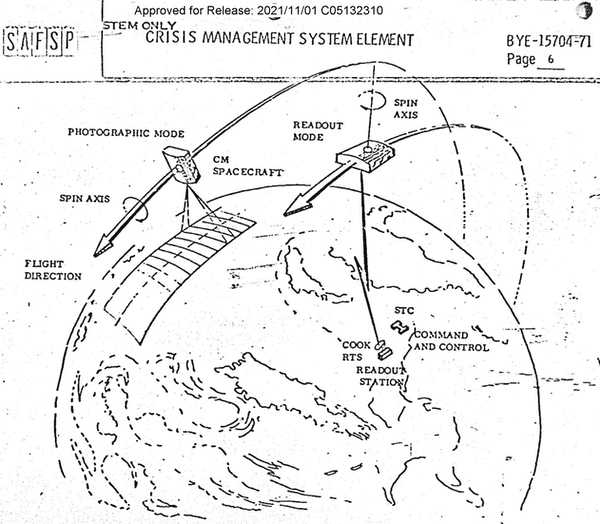Spinning towards the future: crisis response from spaceby Dwayne A. Day
|
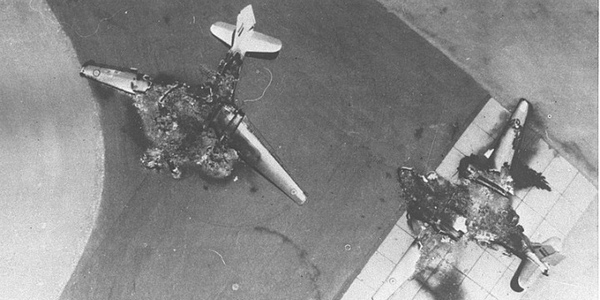 Egyptian aircraft destroyed by the Israeli Air Force during the Six-Day War of June 1967. The war happened so quickly that U.S. intelligence agencies struggled to understand what happened. Over 300 Egyptian aircraft were destroyed. (credit: Israeli Air Force) |
Film-scanning
The technology to scan a photograph with a light beam and transmit an analog signal along a phone line to a receiver where it could be reconstituted into a photograph had existed since the 1940s. Variants of this technology had been used commercially at newspapers, enabling photographs to be transmitted great distances so that they could appear in multiple newspapers across the country.
| SPIN SCAN came closer to development than any of the other crisis reconnaissance satellites evaluated during this period. But the two significant intelligence failures of the late 1960s did not lead to its approval. |
Studies of satellite reconnaissance took place at the RAND Corporation in Santa Monica, California, and at the initiative of the Wright Air Development Center in Dayton, Ohio, from 1952 to 1956, and the early concepts focused on using a TV camera to produce the imagery.[1] But in 1956, the Air Force selected film-scanning technology for spaceflight and began work on a satellite capable of exposing film in orbit, developing the film using a “bimat” process that was the equivalent of pressing the film against a sponge saturated with a development chemical, and then scanning the developed film with a “flying spot scanner.” The light pulsed from the scanner would be converted into signals that were then beamed to the ground. Lockheed was given the contract to develop the satellite and Eastman-Kodak was selected as the contractor for the optics and film-processing systems.
By 1958, the satellite program continued to evolve until it was eventually named Samos. The first satellite, known as the Samos E-1, used the “film-relay” process to produce low-resolution photographs from space. The follow-on Samos E-2 program used the same process to produce higher-quality images. The first Samos E-1 satellite launched in October 1960 and failed to reach orbit. The second launched in January 1961 and had limited success. The Samos E-2 program had a single launch in September 1961, which ended in failure.
As the United States developed its satellite reconnaissance capabilities in the 1960s, it quickly abandoned the film-readout technology of the Samos E-1 and E-2 programs and along with it the concept of receiving satellite photos soon after they were taken. The problem was that the satellites could not transmit more than a few dozen images each during a day, far too few to be useful for strategic intelligence purposes such as counting Soviet weapon systems.
Instead, the US intelligence community chose quantity and quality over speed, developing systems like the CORONA satellites that could take thousands of photos in a period of days and then return them to Earth, and the GAMBIT satellites, which took fewer, higher-resolution photographs, and also returned them to Earth a few days later. Satellite technology was insufficiently advanced to return many, or good quality, photos quickly during this time period.
This technological limitation also affected how and for what purpose the photos were used. By the early 1960s, satellite photos became a powerful strategic assessment resource. They provided indications of what types and how many weapons the Soviet Union possessed: missiles, bombers, submarines, and tanks, as well as factories, production facilities, and other capabilities. Satellites could not provide crisis warning intelligence, but intelligence analysts were increasingly deluged with data for strategic assessments, and they did not place a high priority on developing satellites for crisis warning, which was already provided by signals intelligence and other sources.
Throughout much of the 1960s, there were still members of the intelligence community who sought to make reconnaissance satellites more timely, but the lack of a clear requirement, and the immaturity of available technology, hampered their efforts. The technology developed for Samos was adapted by NASA for use in the Lunar Orbiter program, where the satellites photographed potential Apollo landing sites, and was used for a ground-based military system in Vietnam named COMPASS LINK. But film scanning and readout was abandoned for military space use for several years as the reconnaissance satellite program evaluated other technologies, none of which were as mature as film-scanning.
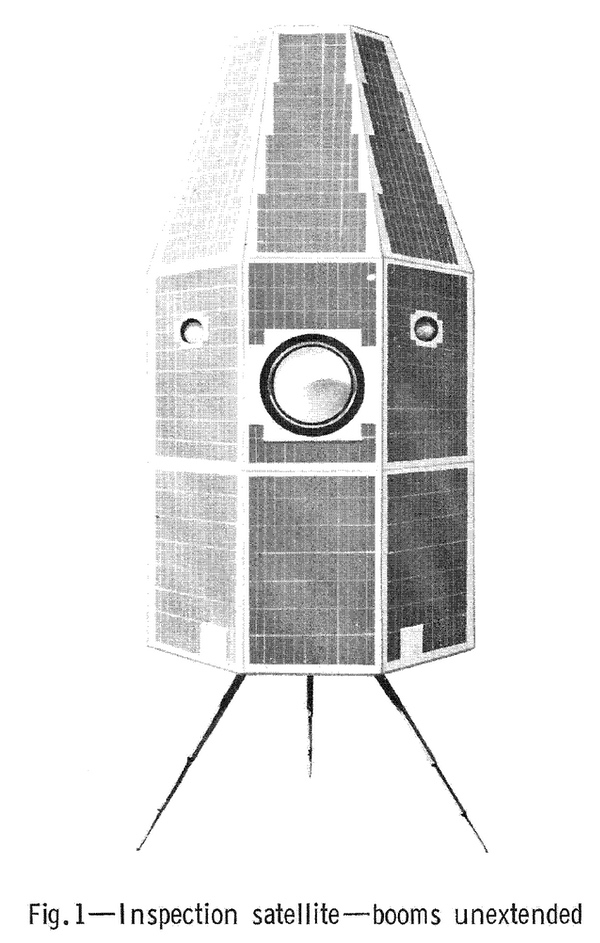 In 1966, Merton Davies of the RAND Corporation proposed an "Inspection Satellite" that used the film-readout technology originally developed for the Samos reconnaissance satellite. Davies' proposal was for a satellite with a less powerful camera than was later proposed for SPIN SCAN. (credit: NRO) |
Film-readout returns
The RAND Corporation’s Merton Davies was one of the first people to study satellite reconnaissance. In 1956, Davies and his RAND co-worker Amrom Katz proposed the film-return satellite that became the CORONA program, which first entered service in 1960. Even though satellite reconnaissance was highly classified during the 1960s, Davies was still able to publish articles about Earth observation, proposing innovative methods of using satellites for low-resolution mapping and other observation missions.
Davies had been one of the key people responsible for the adoption of film-return technology over film-relay, but he believed that the latter still had value. In October 1966, Davies wrote a paper for RAND where he proposed a satellite using the readout technique.
Davies’ concept was for an “inspection satellite” that would take several pictures on film each day for 100 days. He noted that the Soviet Lunik III and Zond 3 “produced pictures of the moon in essentially the same manner.”[2] By mentioning the Soviet use of the technology, Davies therefore was not shedding any light on American use of the technology such as Samos.
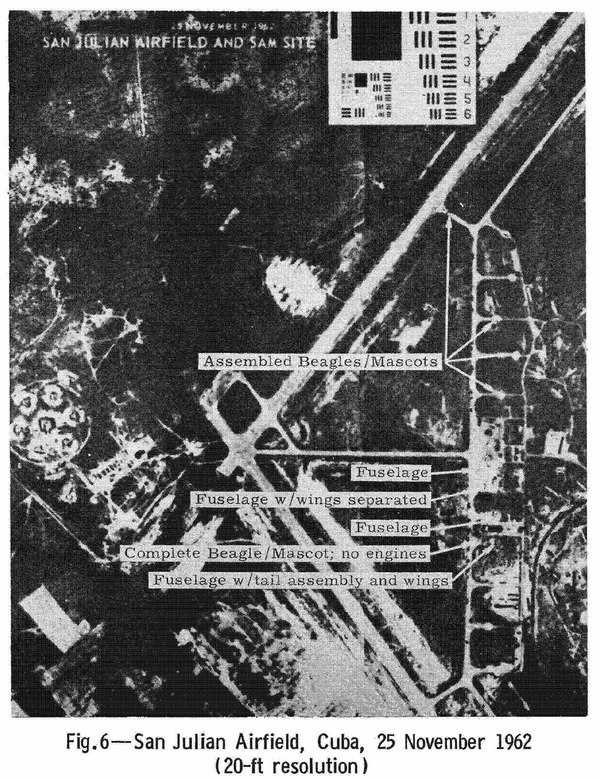 To make his point, Merton Davies took U-2 reconnaissance images of Cuba and degraded them to show that even a lower-resolution satellite system could still provide useful images and do so within 24 hours. (credit: NRO) |
Davies proposed a spinning satellite with a panoramic camera with a 0.8-meter (30-inch) focal length. The satellite would weigh 113 kilograms (250 pounds) and be deployed in a 232-kilometer (125-nautical mile) orbit. The exposed film would be processed in the satellite, scanned, and the pictures transmitted to the ground. Davies noted that photography with ground resolutions of 3 to 15 meters (10 to 50 feet) would be useful for arms control. To test the concept, he used U-2 photography of Cuba taken during the 1962 Missile Crisis and re-photographed it to decrease the resolution. This provided an indication of what the satellite could see from a higher altitude. For instance, it could spot fixed surface-to-air missile sites, but not mobile ones like then in use in Vietnam.[3]
In June 1967, Davies published his RAND paper in the journal Astronautics & Aeronautics, produced by the American Institute of Aeronautics and Astronautics.[4] Despite Davies proposing the concept, it appears that when it was formally studied for development starting in 1967, his proposal was largely forgotten. The concept, however, was not.
The need for timely imagery
General Lew Allen is today one of the more important but overlooked figures in the United States’ space program. Allen had been a B-29 and B-36 bomber pilot in the late 1940s before getting a Ph.D. in nuclear physics in 1954. By the early 1960s he was working in Air Force space programs before being assigned to the NRO, where he oversaw various programs, including film-readout systems. By 1971 he was a brigadier general as the head of the NRO’s headquarters staff in Washington and would soon be named head of the Secretary of the Air Force Special Projects office (also known as SAFSP, the NRO’s Program A) in Los Angeles. He would later go on to become a full general, run the National Security Agency, become Air Force Chief of Staff, and upon leaving the Air Force in 1982, he became director of the Jet Propulsion Laboratory. Allen’s memos to the NRO Director in the early 1970s were often slightly rambling but filled with inspired observations about the difficult choices the NRO, particularly its West Coast office, faced.
| Timeliness, Allen wrote, “is a factor to inspire dreams.” By that he meant that there were many different ways to achieve it, and it made the engineers excited because of all the possibilities. |
In 1974, Allen wrote an extended commentary about a top secret draft NRO history about the development of near-real-time satellite reconnaissance written by historian Robert Perry. Allen discussed what he referred to as the conflict between requirements for new reconnaissance systems vs. the “technological imperative”—meaning simply pushing the technology as far as it could go regardless of any specific requirement. Allen observed that there were essentially three aspects to satellite reconnaissance. The first was quality, which mainly meant the resolution capability of a system. The second was quantity, which primarily referred to how much area coverage a satellite could provide. The third was timeliness. “There can be developed a logical description of requirements, as it relates to each factor,” Allen wrote, “but in truth (as Katz would say) the developments have been driven by the ‘technological imperative’ and the requirements here caught up later.”[5]
Quality—the desire for higher and higher resolution photographs from space—drove the NRO to develop the GAMBIT system, the Manned Orbiting Laboratory (MOL) and its DORIAN optics system, and then to pursue improvements to GAMBIT. Quantity—the need for area coverage—led to the first reconnaissance satellite, CORONA, in 1959, followed by its replacement the HEXAGON system, which first flew in 1971. Allen viewed HEXAGON as an “ultimate” system. Its success had left the need for quantity “unfruitful for further dreams.”[6] Fifty years later, his observation about HEXAGON has proven prescient and the system has not been bettered.
Timeliness, Allen wrote, “is a factor to inspire dreams.”[7] By that he meant that there were many different ways to achieve it, and it made the engineers excited because of all the possibilities. However, “the need was never really there,” Allen conceded. “In a sense, the ‘technological imperative’ was the thing.”[8] But unlike for reconnaissance quantity and quality, the technology proved stubborn and throughout the 1960s it never matured sufficiently to result in development of an operational system.
“As the enormous value of overhead recce became more appreciated, it was always the strategic concept which dominated – technological advancement of Soviet weaponry – SALT – order of battle, etc.,” Allen wrote. As a result, near-real-time imagery “was a factor to be worked on, but not worth much.”[9] Surprisingly, not even the biggest international crises of the 1960s provided sufficient justification.
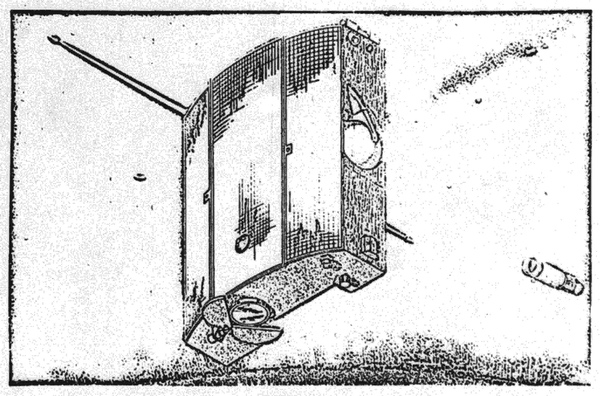 The NRO began contractor-led studies of SPIN SCAN in 1967. The studies produced several potential satellite options based upon mass and capabilities. The smallest satellites could have been launched from a much larger HEXAGON satellite. By 1971, the smaller options had been rejected as not meeting the requirement to enable identification of vehicle-size objects on the ground. Instead, a larger satellite would have been launched on an Atlas F rocket. (credit: NRO) |
SPIN SCAN
In 1964, the National Reconnaissance Office, which operated the United States’ fleet of intelligence satellites, began a policy to always keep a CORONA photo-reconnaissance satellite ready to go on relatively short notice. One satellite would be kept ready to launch within nine days of a launch decision, with six more capable of launching within 38 days. The goal was to have a satellite ready for crisis situations. The satellites used film, which they returned to Earth in reentry vehicles, and although this policy could enable faster launches, it still meant that satellite photos would not reach decision makers in Washington until several days after they were taken, and at the very least more than a week after a decision had been made to launch the satellite. But it was the best capability available at the time. CORONA satellites were relatively inexpensive and they were launching at a rate of nearly one a month.[10]
By 1967, CORONA was scheduled for retirement and replacement by a much larger and more capable satellite named HEXAGON that would only launch three or four times a year, cost three times as much as CORONA, and not be capable of launching on short notice. HEXAGON’s impending service led NRO officials to begin considering how to maintain at least the level of response to crisis situations that CORONA had provided.[11]
In June 1967, Israel engaged in a pre-emptive war against several of its neighbors. The Six-Day War, as it came to be known, happened so quickly and effectively that US intelligence agencies struggled to keep up with developments. The Israelis claimed to have caused significant damage to Arab airfields, which US leaders doubted occurred until it was later confirmed by CORONA imagery.[12] In August 1968, Soviet forces invaded Czechoslovakia to suppress the “Prague Spring,” a movement that Soviet leadership believed threatened the stability of a communist ally. An after-action report by the intelligence community stated that “The intention to invade was not known until after the fact. The lack of ability to assess more accurately the likelihood of this intention was the point of intelligence failure in the Czech crisis.”[13]
General interest in “quick response,” as well as concern about survivable reconnaissance systems, had already led to an initial round of studies for new approaches and new systems in the mid-1960s. One of these was maintaining CORONA vehicles in inventory for contingency operations. Another option was an advanced hypersonic aerodynamic vehicle named ISINGLASS, which was never developed due to technical limitations and immense cost. A third option was drones, such as the D-21 TAGBOARD reconnaissance drone, which was developed and deployed against targets over China, but proved unreliable.[14]
Although the capability to launch a CORONA satellite on short notice in event of a crisis situation, or to return its film earlier to decrease the time to analysis, had both existed for several years, neither option had been used. A reconnaissance satellite was too precious a commodity to cut short its mission.[15] As Lew Allen explained in an early 1970 letter to Dr. Eugene Fubini, the deputy director for research and engineering at the Department of Defense, “historically, the interest in crisis situations has never transcended the importance of strategic intelligence.”[16]
Both the Six-Day War and the Czech invasion prompted the NRO to sponsor a series of contractor studies of different concepts for “crisis-response” satellites. These studies, with names like FASTBACK and AXUMITE, involved quick-reaction launches and various methods for returning imagery to Earth more quickly than the existing film-return systems like CORONA and GAMBIT. The studies took place in 1968 and 1969. But both FASTBACK and AXUMITE would be launched from locations that were not typically associated with reconnaissance satellites, and they would generally only conduct a single orbit, meaning that they could appear to an adversary to be a weapon launch.
The NRO study of a SPIN SCAN satellite started in 1967 and predated the Czech invasion and possibly even the Six-Day War. Instead, SPIN SCAN apparently initially was a response to the NRO’s changing reconnaissance portfolio.[17] The HEXAGON area search reconnaissance satellite was then in development to replace the CORONA satellite, and like CORONA it would also use film, returned to Earth in four reentry vehicles compared to CORONA’s two. Whereas CORONA satellites were launched on an almost-monthly basis, when it entered service in 1971, HEXAGON would have a much lower launch rate of four missions per year. CORONA satellites were then held in a launch readiness state making it possible to launch within a few weeks’ notice. The goal was to eventually have a “pipeline” of HEXAGON vehicles, with one ready to launch within 20 days. But this created a dilemma: it would no longer be possible to quick-launch a satellite for crisis response.[18] With CORONA scheduled for retirement, some members of the reconnaissance community believed there was a need for a satellite that could provide faster response time and fill in the gaps created by a late HEXAGON mission.
In addition, the Soviet Union was developing a non-nuclear ASAT weapon, which some feared could be used against American satellites. CORONA satellites were already equipped with a countermeasures system for dealing with Soviet ASATs. But the NRO was concerned that even the suspicion that the Soviet Union was interfering or about to interfere with an American reconnaissance satellite could hamper US satellite operations. SPIN SCAN could mitigate the risks. Two SPIN SCAN satellites could be carried into orbit on a HEXAGON satellite and deployed, possibly going dormant for up to a year and waiting to be activated when needed, therefore ensuring that the United States had three photo-reconnaissance satellites in orbit, with SPIN SCAN providing crisis reconnaissance if necessary.[19] Alternatively, multiple satellites could be launched on a dedicated rocket.[20]
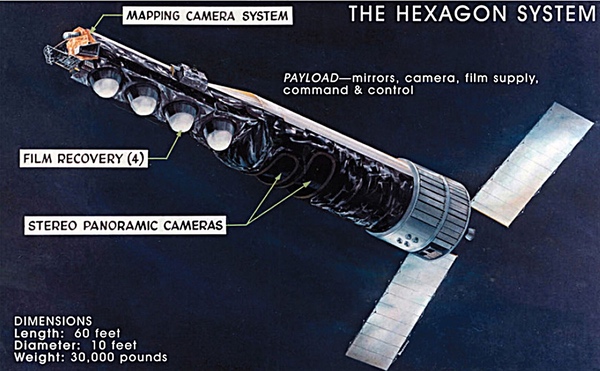 The massive HEXAGON satellite entered service in 1971 and was capable of carrying smaller satellites into orbit. Midway along the forebody in this image is a small, box-like, Program 989 signals intelligence satellite. That location also could have carried a much larger SPIN SCAN imagery satellite. SPIN SCAN could have provided faster imagery return to the ground in event of crisis situations. (credit: NRO) |
The basic requirements for SPIN SCAN were: use of existing technology, weight of 204 to 308 kilograms (450 to 680 pounds) to be compatible with launching from the HEXAGON, resolution at least as good as CORONA, readout for daily return of imagery, area coverage of crisis regions daily, and propulsion to adjust the orbit for specific area coverage. There was one other still-classified requirement that probably pertained to the ability to maneuver to avoid Soviet ASAT attack.[21]
The satellite would have been a flat rectangle spin-stabilized at 29 rpm, with a panoramic camera mounted normal to the spin axis. During photography, the spin axis would be parallel to the Earth’s surface, providing an access swath of 333 kilometers (180 nautical miles). After passage over the “crisis area,” the spin axis would be pointed toward the sun to provide maximum exposure of solar cells on the broad side of the satellite and reduce drag by orienting the satellite to fly “edge-on” at perigee when no photography would be taken. Exposed film would be processed on board using the bimat process developed for Samos, and then the processed film would be scanned by a laser scanner and the video transmitted to the tracking station where the pictures would be reconstructed with a laser recorder.[22]
| In September 1969, SPIN SCAN was briefed to the National Reconnaissance Office’s Executive Committee. But there was no interest among the senior officials in approving development. |
By 1969, SPIN SCAN was extensively evaluated. Two funded and two unfunded studies were performed.[23] Two of the contractors were TRW Systems and General Electric Company. [24] Assessing ground force activity required the best resolution from a crisis response system, which drove the designers towards a larger satellite to incorporate a longer focal length camera needed to achieve such resolution.[25]
According to a declassified analysis, during the Six-Day War, SPIN SCAN would have enabled “assessment of the damage at Egyptian airfields, the dispersal and status of Israeli combat aircraft, the deployment of forces along the Israeli border, and the condition of the Suez Canal. During the Czech crisis an assessment of Soviet air order of battle in Western Russia could have been made, Soviet ground activity at major transshipment/staging areas could have been detected, and major changes in equipment levels at established ground force garrisons could have been confirmed.”[26]
SPIN SCAN also offered another advantage. If the Soviet Union sought to conceal activity, the United States could put several satellites in orbit, phased around the orbit prior to the first pass over the Soviet Union, providing access to the entire area on the first day. The Soviets had “a very limited capability to intercept on early passes,” meaning that the data could be quickly recovered. “…the satellites would have a high probability of providing intelligence in spite of Soviet negation attempts.”[27]
The contractors estimated that if one of them was selected to build the satellite, two demonstration systems could be ready for launch 23 and 26 months from program go-ahead.[28]
In September 1969, SPIN SCAN was briefed to the National Reconnaissance Office’s Executive Committee, which consisted of the Deputy Secretary of Defense and the Director of Central Intelligence, and which approved all new NRO programs. But there was no interest among the senior officials in approving development.[29] They had bigger things on their minds.
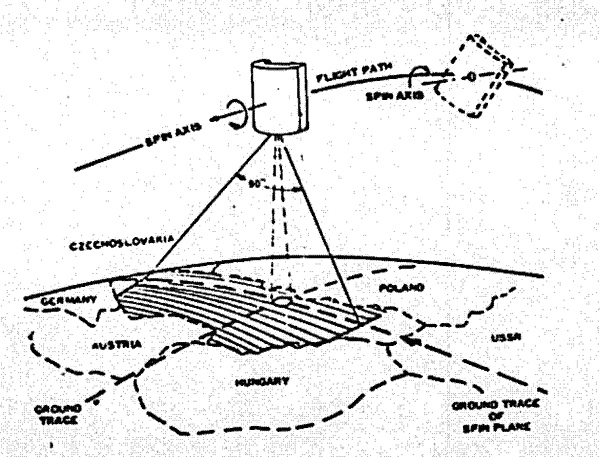 One of the events that led the National Reconnaissance Office to study crisis response satellite designs was the 1968 Soviet invasion of Czechoslovakia. Here SPIN SCAN is shown imaging that area of the world. (credit: NRO) |
FROG and ZAMAN
By the late 1960s, a rivalry was brewing between the advocates of two competing technology approaches to obtain year-round near-real-time imagery of the ground. That rivalry would soon become more heated, and SPIN SCAN would get sucked into it.
One approach, advocated by SAFSP, the NRO’s Los Angeles program office, used the film-scanning technology created for SAMOS, but updated it, replacing the white light sensor that scanned the film with a laser scanning system. This technology would be incorporated into the front end of the new GAMBIT-3 reconnaissance satellite, which had a powerful camera system. The film-scanning system would replace the GAMBIT’s reentry vehicle section.[30] The so-called Film Read-Out GAMBIT, or FROG, satellite concept was first proposed in the mid-1960s. The concept at that time was for a satellite with a 30- to 60-day lifetime that could be extended to a year with major modifications. FROG would produce much better photographs than SPIN SCAN for a longer period of time by providing near-real-time reconnaissance. But FROG was put on ice for several years until it was revived in 1969.[31] (See “FROG: The Film Read Out GAMBIT program,” The Space Review, February 7, 2022.)
FROG’s advantage was that it used an existing camera system and (mostly) existing technology. FROG would be relatively inexpensive to develop, with proven technology requiring no new investment. Its disadvantage was that the satellites could still only relay a limited number of photographs each day, and its overall lifetime was at most approximately one year.[32]
The other near-real-time reconnaissance technology approach was being pushed by the CIA at its headquarters outside Washington. The CIA had an office that formed a component of the NRO and was known as Program B. But because the office resided within the CIA, it often acquired the clout—and the bareknuckle tactics—of the agency when fighting bureaucratic battles. The CIA was advocating for a program then known as ZAMAN, which used an electro-optical sensor at the focal point of a big mirror to turn images into electronic impulses that could then be transmitted to a ground station where they would be converted back to images. The system used no film and had few moving parts, but for years it was unclear exactly what kind of image sensor technology would best be suited to the mission.
ZAMAN’s advantages would be that it could theoretically produce many images per day, last at least three years in orbit, and had substantial growth potential, unlike FROG. Its disadvantage was cost and the required development of several new technologies, not only the imaging sensor, but large, lightweight mirrors, fine pointing controls, a new communications relay technique involving high frequencies, as well as data-relay satellites. The president of Polaroid, Edwin “Din” Land, was a senior intelligence advisor who had provided significant advice on the development of new reconnaissance systems. Land was a respected and unwavering advocate for ZAMAN, and equally critical of FROG. (See “Intersections in real time: the decision to build the KH-11 KENNEN reconnaissance satellite,” The Space Review, September 9, 2019, and part 2.)
| At some point during 1970, SPIN SCAN had been expanded in scope, growing into a family of options based upon requirements. |
FROG was less expensive than ZAMAN, but both were large satellites intended to provide year-round reconnaissance coverage. Both satellites could support the intelligence community’s requirements for strategic reconnaissance (i.e. counting missiles, bombers, and other weapons), as well as crisis reconnaissance. The question was which one would eventually be selected. Although SPIN SCAN used the same technology as FROG, it was only intended to operate for up to a month at a time and lacked many of the capabilities of the two bigger systems.
In November 1970, the NRO briefed officials at the State Department about various crisis response satellite options. The first part of the presentation was about actions taken by the NRO at the request of the State Department to insure that a GAMBIT film-return satellite could cover the Middle East Cease Fire Zone after the termination of the cease fire agreement on November 5.[33]
The rest of the briefing was about the crisis response options that had been under consideration for the past few years. A number of those present were enthusiastic about SPIN SCAN. But Ray S. Cline, State’s director of intelligence and research, downplayed SPIN SCAN. “In his opinion, endorsement of the SpinScan, although attractive, would detract monetarily from the aggressive pursuit of a real-time readout system which he desires at the earliest possible date,” according to a summary of the discussion. Cline stated that the NRO indicated that by 1974, using film-return satellites only, it would have photographic coverage 365 days a year, but that deciding to bring down a film capsule early would be a difficult decision, which is why he was an advocate for the real-time readout system.” According to the NRO official who recorded the meeting, Cline’s staff was surprised about the high costs of some of the new crisis response satellites.[34]
FROG vs. ZAMAN at ExCom
In January 1971, following pressure from the State Department for what some were calling the “Model T” approach (after the famous and relatively inexpensive Ford automobile of the early 1900s), the ExCom met to consider the various crisis-response systems. FASTBACK had by this time been re-proposed as a longer-life system, but it and AXUMITE were too limited and provocative for consideration. Nearly a dozen new options had also recently been studied. These were different variations on existing systems, like adding reentry vehicles to CORONA and GAMBIT satellites to enable earlier return of exposed film. Another candidate was named PINTO, after the inexpensive car that would soon become notorious for catching fire. PINTO would have used an existing aerial camera and CORONA film return capsules.[35] (See “National Reconnaissance Program crisis photography concepts, part 1: A six-pack of Corona,” The Space Review, May 31, 2022, and “National Reconnaissance Program crisis photography concepts, part 2: PINTO,” February 6, 2023.)
But the most attractive option to many involved in the deliberations was an upgraded SPIN SCAN. At some point during 1970, SPIN SCAN had been expanded in scope, growing into a family of options based upon requirements. Although the initial concept had been a satellite weighing 204 kilograms (450 pounds), this had grown to 272 kilograms (600 pounds), and then grew again to 396 kilograms (875 pounds) as the design was refined. Two HEXAGON-deployed versions massing 396 and 544 kilograms (1,200 pounds) were considered to be the baseline systems for deployment from the HEXAGON, although they would not satisfy the existing requirements.
The final design would have weighed 726 kilograms (1,600 pounds), been too big for the HEXAGON, and instead required a converted Atlas ICBM known as the Atlas F. It was selected over the lighter versions based on image quality, coverage, and ability to select the desired orbital inclination. It would have been capable of operating in an orbit of 167 by 389 kilometers (90 by 210 nautical miles) for a month or more, providing 0.76- to 0.91-meter (2.5- to 3-foot) ground resolution. This weight was too high to launch more than one satellite on an Atlas F rocket and the earlier concept of placing several in orbit on the same launch to improve survivability was not possible.
By spring 1971, the FROG vs. ZAMAN debate was coming to a head, with senior intelligence advisors and leaders discussing the two options and their costs and limitations.[36] In the midst of this debate the concept of an “interim crisis-response” satellite remained alive, largely at the impetus of the State Department. SPIN SCAN was also the preferred system for this mission. It was not capable of providing the same kind of resolution as ZAMAN or FROG, but was not intended to.
In April 1971, the Committee on Overhead Intelligence Requirements (COMIREX) finished an analysis of needs for an interim crisis response system capability. They determined that designers “should plan for three to five critical situations each year, with perhaps two of these occurring simultaneously.” The system should also be able to sustain daily access to one or more widely separated crisis areas for periods of approximately one month.[37] The goal was to have an imagery swath width of five nautical miles wide.[38]
| Allen provided the Director of the NRO John McLucas his views on the merits of all the options for an interim system, concluding that SPIN SCAN was the best option, but admitting that it probably was not something the NRO needed to develop. |
Also in April 1971, the NRO’s Executive Committee discussed FROG vs. ZAMAN and further discussed the interim crisis reconnaissance satellite options.[39] An NRO staff evaluation of the options stated that “SPIN SCAN appears to be the best choice” if the ExCom decided to select an interim quick response system. It also noted that the system would be obsolete with the introduction of a near-real-time system, meaning that SPIN SCAN would have an operational lifetime of about three years, assuming it entered service by 1973.[40]
The NRO’s preferred SPIN SCAN system weighed 1,600 pounds and used a dedicated Atlas F booster. The size was dictated by the resolution requirement, which demanded a 1.5-meter (60-inch) focal length, F/4.3 optical system.[41] A single SPIN SCAN could be able to provide daily access to a single crisis area for up to eight weeks, twice the required duration.[42] One limitation was that it would probably take twice as long—up to 24 hours—as required to access the necessary area and return imagery.[43]
The NRO estimated that if the Soviets initiated attacks against its larger reconnaissance satellites such as GAMBIT and HEXAGON, SPIN SCAN would probably survive for several orbital passes before a Soviet ASAT blew it out of the sky.[44]
The NRO noted that SPIN SCAN had by that time been studied by four aerospace contractors and an optical system contractor, resulting in high confidence in the cost, schedule, and performance numbers. But SPIN SCAN could not replace or reduce the quantity required for existing photo-reconnaissance systems.[45]
Many different options were on the table in April 1971.[46] Brigadier General Lew Allen, the head of the NRO Staff in Washington, DC, provided the Director of the NRO John McLucas his views on the merits of all the options for an interim system, concluding that SPIN SCAN was the best option, but admitting that it probably was not something the NRO needed to develop. He ended his memo with a telling indication of his thinking: “I apologize for all the words, my negative views are not meant as opposition to progress but rather a strong desire that we start on a plan we can realistically expect to finish—we can’t stand another MOL.”[47] Allen was referring to the costly and controversial Manned Orbiting Laboratory, which was canceled in summer 1969 after the expenditure of over a billion dollars. SPIN SCAN would not cost anywhere near as much, but clearly Allen had been burned by the experience.
For the April 1971 ExCom meeting on an interim crisis-reconnaissance system, SAFSP prepared a detailed report on SPIN SCAN, focusing on the largest option.[48] The report indicated that “larger optics, extensive maneuvering, and maintenance of a 167 x 389 kilometer (90 x 210 nautical mile) orbit for a month or more have necessitated abandonment of the [HEXAGON] piggyback idea in favor of launch-on-demand using Atlas E/F.” [49]
The satellite was described as a rectangular box about 1.2 by 2.1 by 0.6 meters (4 by 7 by 2 feet), weighing 726 kilograms (1,600 pounds). The satellite would be placed into sun-synchronous orbit at the onset of a crisis, or upon some other criteria that remains classified to this day, but probably was linked to the survivability of the other reconnaissance satellites then in service. The spin axis would be parallel to the Earth’s surface while flying over the target and taking photographs, and then would be pointed towards the sun to expose the solar cells on the broad area of the satellite and reduce atmospheric drag.[50] The film would be processed on board, scanned by a laser scanner, and then the video would be transmitted to Earth via a 76-megahertz bandwidth channel. The satellite would have expendables to permit about eight weeks’ operation.[51]
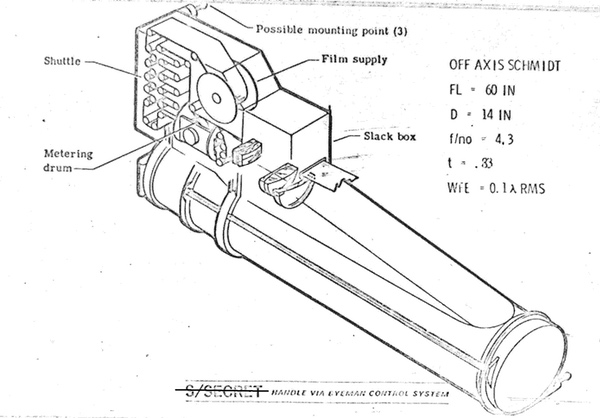 The SPIN SCAN camera had been studied by the Itek Corporation, which developed the CORONA reconnaissance camera. By the late 1960s, Itek had angered the CIA and primarily relied upon the Air Force side of the NRO for reconnaissance work. (credit: NRO) |
Optics, film handling, and laser scanner would occupy about two-thirds of the satellite volume, with the rest being taken by attitude control and orbit adjust propellants and the electronics for programmer, telemetry and communications, servos, and the photographic data link.[52] The camera would be manufactured by Itek, which made the CORONA cameras.[53] The camera length would be about 1.8 meters (6 feet) and the subsystem would weigh about 159 kilograms (350 pounds). The camera concept was described as an off-axis Schmidt with a 1.5-meter (60-inch) focal length and an aperture diameter of 36 centimeters (14 inches). The camera would take mono, not stereoscopic, images.[54]
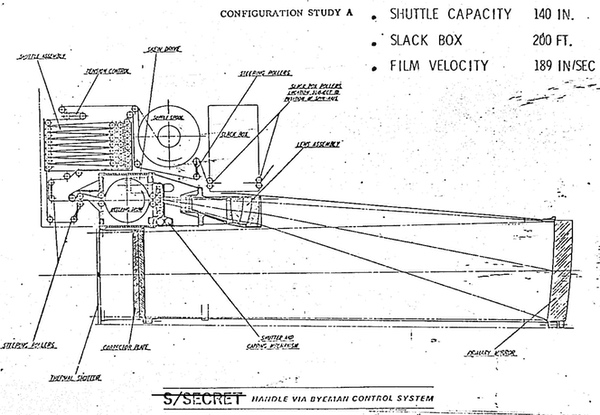 The SPIN SCAN camera was an off-axis Schmidt design that used a primary mirror to bend and focus the light that entered from the left in this illustration. (credit: NRO) |
The spacecraft would be equipped with two hydrazine fuel tanks pressurized by nitrogen from a high-pressure tank. All rocket thrusters would be located at one corner of the spacecraft. By carefully timing the thruster pulses, a second set of thrusters was unnecessary.[55] Over 25% of the spacecraft mass was hydrazine (425 pounds), dictated by the mission lifetime and another classified requirement that probably involved the ability to change orbit to avoid Soviet ASAT weapons.[56]
The bimat processing material could be stored for years at a temperature of 2.8 degrees Celsius (37 degrees Fahrenheit), but the film had to be about 21 degrees Celsius (70 degrees Fahrenheit) to be developed properly. The solution was to introduce the exposed film to the bimat storage box through a vapor seal, press the film and bimat together, and electrically heat them to 70 degrees. The film would move slowly but continuously through the bimat box before exiting into an enclosed space where it would be heated to dry it. Both NASA and the military had extensive experience with bimat, both in space for NASA’s Lunar Orbiter and on the ground for various military programs.[57] The laser scanner would use a helium-neon laser emitting monochromatic red light.[58]
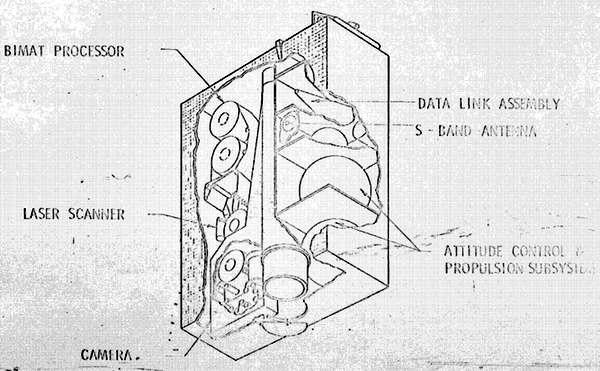 SPIN SCAN was a box with much of the interior taken up by the camera and the film and processing system. It was also equipped with a propulsion system that was apparently designed to enable the satellite to change orbit to avoid Soviet ASAT weapons. (credit: NRO) |
The Cook Tracking Station at Vandenberg Air Force Base and the Boss Tracking Station at New Boston, New Hampshire, had long supported the CORONA as well as other reconnaissance satellite programs. They could be easily modified to serve as the ground stations for SPIN SCAN.[59]
The satellite would be required to read out 10,360 square kilometers (4,000 square nautical miles) per day during 13 minutes of contact time. Using the two ground stations would provide at least 20 minutes of readout time per day. Reading out the imagery to Boss would be preferable, because it was closer to Washington, DC, and the images would be sent by courier to Washington—a delay in getting the images to decision makers that probably would have been reevaluated.[60]
The Atlas would be launched from complex BMRS-A at Vandenberg, which was specially equipped to enable an Atlas to stay on the pad at an indefinite hold at T minus two hours for up to at least six months. The gantry would remain around the missile. The report concluded that “the major limitation to quick launches is probably the range safety problem in controlling traffic, trains, and ships at sea.”[61]
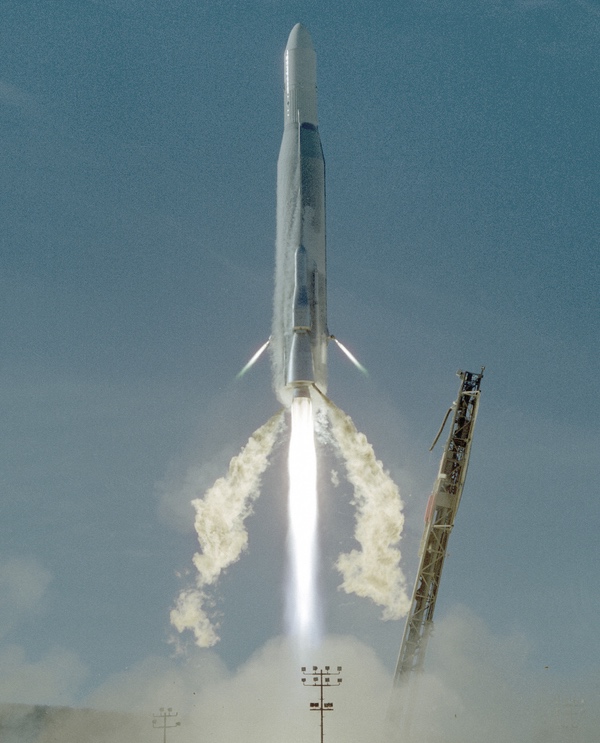 The final iteration of SPIN SCAN would have been launched on a converted Atlas ICBM and known as the Atlas F. The rocket could have been kept on its pad for many months, ready to launch within hours and provide crisis-reconnaissance of much of the world. (credit: NRO) |
Atlas E/F reliability was then around 90%, with 34 out of 38 refurbished Atlases functioning properly since 1966. If near-100% reliability was desired, SPIN SCAN could switch to the SLV-3A Atlas, a dedicated space launch vehicle, but at an increased cost of an extra $3.5 million per launch.[62] Launches would take place near midnight at Vandenberg in order to achieve the required illumination over the targets.[63] It would provide coverage of the complete Suez cease-fire area on the first pass. The Israel/Jordan border areas could be covered on a subsequent day by shifting the ground track.[64]
The report did acknowledge that “command and control requirements are also complicated because of the many maneuvers required for the spinning satellite.”[65]
The April 1971 ExCom meeting led to a decision to not develop SPIN SCAN, and to proceed with development of FROG, delaying development of the expensive ZAMAN. By the end of April, the NRO issued preliminary contracts for the FROG spacecraft to Lockheed and to Kodak for the optical system.
In August 1971, senior intelligence advisor Richard Garwin “requested a refresher briefing” on the interim crisis response systems that had been rejected by ExCom in April. Garwin’s primary interest was in SPIN SCAN, particularly the 272-kilogram (600-pound) vehicle that had been proposed in the past because it could be carried on the HEXAGON. However, the current design for carrying on HEXAGON had grown to 397 kilograms (875 pounds). Garwin wanted to know if HEXAGON could carry into orbit two of the 397-kilogram SPIN SCANS, or two more-capable 544-kilogram (1,200-pound) versions. He wanted to know their capabilities as well as the program costs and schedules for these options. But Garwin’s query did not lead to any change in the decision to shelve SPIN SCAN.[66]
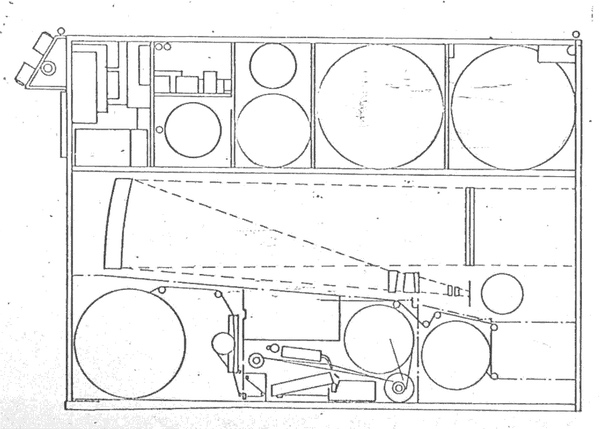 One unusual aspect of the SPIN SCAN design is that the jets for spinning the satellite were located on only one corner of the spacecraft. (credit: NRO) |
By November 1971, after strong lobbying by the CIA that eventually involved President Richard Nixon, FROG development was canceled and ZAMAN was approved for immediate development. Soon thereafter, its name was changed to KENNEN and it also received the designation KH-11. After considerable expenditure but only slight delay, KENNEN entered service at the end of 1976. There was no interim crisis-response system during this time, but the NRO continued launching HEXAGON and GAMBIT satellites and did not retire those programs until the 1980s.
Interim crisis-response is rejected
Even if SPIN SCAN could have gained some support as an interim system to fill the gap until ZAMAN/KENNEN became available, the CIA opposed any system that undercut the justification for ZAMAN, even a little bit.
Lew Allen, who had been involved in advocating for both FROG and SPIN SCAN, had his own perspective on what had happened. “I had the cynical view during much of this period (not really shared by McLucas or Schlesinger, I must say) that our work on FROG or SPIN SCAN was for the purpose of showing that it was not mandatory to proceed with KENNEN – I felt if KENNEN were ended, FROG would not be far behind; and of course, the concern with KENNEN was quantitative—cost, schedule, risk—was it really worth all that? Many felt not, but felt obliged to generate alternatives rather than only be negative,” he wrote. “Although I supported FROG and SPIN SCAN institutionally, my heart wasn’t in it—they should not have gone forward.” [67]
| Even if SPIN SCAN could have gained some support as an interim system, the CIA opposed any system that undercut the justification for ZAMAN, even a little bit. |
It was a view that Allen had developed over time, primarily influenced by seeing the cost growth on the HEXAGON (and possibly the RHYOLITE signals intelligence) satellite systems. “I am very worried that we have managed, in almost every part of the NRO, to devise a second generation system which is very complex and very expensive and very much better in capability. But in every case there is now at least some question as to whether the increased capability is worth the increased cost. We used to think that the demand for improved coverage would result in six HEXAGON launches per year. There are many now who feel that considering the great capability and cost of the system, really only two would meet essential needs. One can’t help but wonder if eight CORONAs would not have been a better buy under those circumstances.”[68]
But by 1974, Allen had concluded that any interest in economy was squashed under the CIA steamroller. “A remarkable aspect of KENNEN history is the awesome effectiveness with which CIA and the Land Panel dedicated themselves to supporting KENNEN once Land made his basic commitment. The only parallel in history is the unified dedication of the Romans to the destruction of all Carthage.”[69]
Note: The author wishes to acknowledge JPII, who got many of the crisis-reconnaissance documents declassified.
Endnotes
- The concept of faster imagery return from space was also studied in the Soviet Union. From 1963 to 1964, the Soviets studied several possible systems for returning imagery to Earth either in the form of film-readout or television systems. They were rejected. Bart Hendrickx, “Instant Imaging: Soviet Television Reconnaissance Satellites,” Space Chronicle, Vol. 1-1, 2021, pp. 15-20.
- Merton E. Davies, “Inspection by Small Satellites,” RAND, October 1966, p. 4.
- Ibid., pp. 4-6.
- Merton E. Davies, “Big Potential for Small Observation Satellites,” Astronautics & Aeronautics, June 1967, pp. 68-72.
- Robert Perry, “NRO History – NRO History Series Chapter 17, Vol. IV, Draft Only,” ca. 1973, p. 1.
- Ibid., p. 3.
- Ibid.
- Ibid., p. 4.
- Ibid., p. 3.
- Colonel Lew Allen, Jr., Director, NRO Staff, Memorandum for Mr. Packard, et. al., “Spin-Scan,” September 12, 1969, p. 1.
- The anticipated HEXAGON launch rate (as of 1969) and per-unit cost is from: Colonel Lew Allen, Jr., Director, NRO Staff, Memorandum for Mr. Packard, et. al., “Spin-Scan,” September 12, 1969, p. 1.
- Frederic C.E. Oder, James C. Fitzpatrick, and Paul E. Worthman, “The CORONA Story,” National Reconnaissance Office, 1987, p. 111.
- Memorandum for the Director of Central Intelligence, “Post Mortem on Czech Crisis,” November 22, 1968.
- Colonel Lew Allen, Jr., Director, NRO Staff, Memorandum for Mr. Packard, et. al., “Spin-Scan,” September 12, 1969, p. 2.
- Brigadier General Lew Allen, Jr., Director, NRO Staff, “to Gene,” [Fubini], January 16, 1970.
- Ibid.
- A 1971 document indicates that SPIN SCAN had been studied “for about four years” as of that time, but whether this started before or after the June 1967 Six-Day War is unknown. See: “SPIN-SCAN FOR CRISIS RECONNAISSANCE,” SAFSP, April 12, 1971, p. 2.
- Colonel Lew Allen, Jr., Director, NRO Staff, Memorandum for Mr. Packard, et. al., “Spin-Scan,” September 12, 1969, p. 1.
- Ibid., p. 5.
- As Lew Allen wrote: “If they chose to harass a system like HEXAGON, the expense and low launch rate would cause us to have very long periods of no coverage even if the Soviets interfered at a very low level, perhaps imperfectly assessed as hostile by us.” Brigadier General Lew Allen, Jr., Director, NRO Staff, “to Gene,” [Fubini], January 16, 1970, p. 2.
- Colonel Lew Allen, Jr., Director, NRO Staff, Memorandum for Mr. Packard, et. al., “Spin-Scan,” September 12, 1969, p. 3.
- “SPIN-SCAN FOR CRISIS RECONNAISSANCE,” SAFSP, April 12, 1971, pp. 4-10.
- Colonel Lew Allen, Jr., Director, NRO Staff, Memorandum for Mr. Packard, et. al., “Spin-Scan,” September 12, 1969, p. 3.
- “SPIN-SCAN FOR CRISIS RECONNAISSANCE,” SAFSP, April 12, 1971, p. 23.
- Colonel Lew Allen, Jr., Director, NRO Staff, Memorandum for Mr. Packard, et. al., “Spin-Scan,” September 12, 1969, p. 5.
- Ibid., p. 7.
- Ibid., pp. 8-9.
- Ibid., p. 11.
- Ibid.
- The first version of the GAMBIT-3 had a single reentry vehicle. A second reentry vehicle was added by 1970.
- Lew Allen concluded that GAMBIT had a low production rate and was preferred for its high resolution, but the main reason FROG was shelved at that time was that “a crisis capability to be called into action after some delay is not very useful.” He added that although many in the reconnaissance community believed that a crisis capability was not needed, there were still some “who remembered Cuba painfully.” Brigadier General Lew Allen, Jr., Director, NRO Staff, “to Gene,” [Fubini], January 16, 1970, p. 2.
- Robert Perry, “NRO History: NRO history Series Chapter 17, Vol. IV, Draft Only,” [version approved for release 3-19-2018], p. 37; Bruce C. Clarke, Jr., Special Assistant to the DDI for Special Projects, Memorandum, Subject: DDI Requirements in Connection with New Reconnaissance System, August 11, 1966; Oder, Fitzpatrick, and Worthman, The GAMBIT Story, p. 86.; Harold L. Brownman, Director of Special Projects, Memorandum for Deputy Director, National Reconnaissance Office, “EOI Briefing Charts Requested by Mr. Sorrels,” March 19, 1971. The limits of how many images FROG could take in high-density target areas are depicted in: Frank J. Denny, Executive Secretary, Committee on Imagery Requirements and Exploitation, Memorandum for holders of COMIREX – M – 127, “Interim Crisis-Response Planning- - Film Readout GAMBIT (FRO-G),” June 15, 1971, p. 32.
- Edwin F. Sweeney, Memorandum for Dr. McLucas, “State Department Briefing,” November 4, 1970.
- Ibid.
- “NRP Executive Committee Agenda, January 29, 1971,” F. Robert Naka, Secretary, NRP Executive Committee, “SPIN SCAN.” This document is attached to: F. Robert Naka, Secretary, Memorandum for Mr. Packard, et. al., “Approval of ExCom Minutes (ExCom-M-24),” February 18, 1971.
- “Should the NRO acquire an interim system with improved imagery response time prior to EOI? If so, what is the desired system approach and what is to be the funding source?” n.d. but most likely early April 1971.
- Ibid., p. 4.
- Ibid.
- SAFSP, “SPIN-SCAN for Crisis Reconnaissance,” April 12, 1971.
- “Should the NRO acquire an interim system with improved imagery response time prior to EOI? If so, what is the desired system approach and what is to be the funding source?”, p. 1.
- Ibid., pp. 8-9.
- Ibid., p. 16.
- Ibid., p. 18.
- Ibid., p. 19.
- Ibid.
- Harry Davis, Deputy Under Secretary (Systems Review), Memorandum for Dr. McLucas, “A Not-too-Thorough and Loose Survey of Possible Photobird Mixes,” April 9, 1971.
- Brigadier General Lew Allen, Jr., Director, NRO Staff, “to Gene,” [Fubini], January 16, 1970.
- “SPIN-SCAN FOR CRISIS RECONNAISSANCE,” SAFSP, April 12, 1971.
- Ibid., p. 2.
- Ibid., p. 4.
- Ibid., p. 5.
- Ibid., p. 7.
- Ibid., p. 25.
- Ibid., pp. 11-12.
- Ibid., p. 27.
- Ibid., p. 43.
- Ibid., pp. 35-36.
- Ibid., pp. 37-38.
- Ibid., p. 39.
- Ibid., p. 41.
- Ibid., p. 45. There were three pads at complex BMRS-A. They were retired in 1974.
- Ibid.
- Ibid., p. 56.
- Ibid., p. 60.
- Ibid., p. 77.
- David D. Bradburn, Memorandum for Dr. McLucas, “Dr. Garwin’s Inquiries on SPIN SCAN,” August 10, 1971.
- Robert Perry, “NRO History – NRO History Series Chapter 17, Vol. IV, Draft Only,” ca. 1973, p. 5.
- Brigadier General Lew Allen, Jr., Director, NRO Staff, “to Gene,” [Fubini], January 16, 1970, p. 4.
- Robert Perry, “NRO History – NRO History Series Chapter 17, Vol. IV, Draft Only,” ca. 1973, p. 6.
Note: we are using a new commenting system, which may require you to create a new account.
